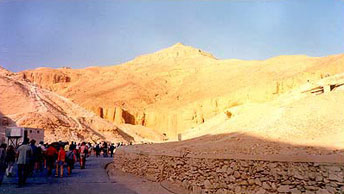 Staff will meet you at your metro area Luxor hotel at 7AM for a exciting and educational day exploring the Necropolis of Thebes. Staff will meet you at your metro area Luxor hotel at 7AM for a exciting and educational day exploring the Necropolis of Thebes.
You will visit the Valley of Kings including entry to King Tut's tomb,
the Valley of Queens, Queen Hatshepsut's Temple, Tombs of the Nobles and Artisans,
Ramesseum, Temple of Medinet Habu and the Colossi of Memnon.
VALLEY OF THE KINGS: Entry to four tombs including King Tut's. A truly impressive site! There, you will find Tutankhamen's tomb which was discovered almost intact in 1922 and the tomb of Ramses IV, among others.
VALLEY OF THE QUEENS: Located on the West Bank of Luxor near the Valley of the Kings, the Valley of the Queens is the place where wives of Pharaohs were buried in ancient times as well as princes, princesses and various members of the nobility.
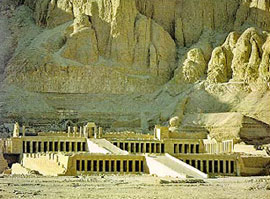 HATSHEPSUT'S TEMPLE: Hatshepsut's temple is considered the closest Egypt came to Classical architecture. Representative of New Kingdom funerary architecture, it both aggrandizes the pharaoh and includes sanctuaries to honor the gods relevant to her afterlife. This marks a turning point in the architecture of Ancient Egypt, which forsook the megalithic geometry of the Old Kingdom for a temple which allowed for active worship, requiring the presence of participants to create the majesty. The linear axiality of Hatshepsut's temple is mirrored in the later New Kingdom temples. The architecture of the original temple has been considerably altered as a result of misguided reconstruction in the early twentieth century AD. HATSHEPSUT'S TEMPLE: Hatshepsut's temple is considered the closest Egypt came to Classical architecture. Representative of New Kingdom funerary architecture, it both aggrandizes the pharaoh and includes sanctuaries to honor the gods relevant to her afterlife. This marks a turning point in the architecture of Ancient Egypt, which forsook the megalithic geometry of the Old Kingdom for a temple which allowed for active worship, requiring the presence of participants to create the majesty. The linear axiality of Hatshepsut's temple is mirrored in the later New Kingdom temples. The architecture of the original temple has been considerably altered as a result of misguided reconstruction in the early twentieth century AD.
THE WORKMANS VILLAGE, an ancient town where workers and artists who created the tombs of the Valleys of the Kings and Queens lived and were buried in. Some of the workers' tombs are beautiful works of art.
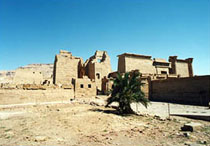 TEMPLE OF MEDINET HABU: The Mortuary Temple of Ramses III has well preserved Ancient Egyptian art and architecture. Walk through the remnants of the workers' mud brick houses at the rear of the site, and then into the grandness of the temples. Hatshepsut and Tuthmosis III oversaw the building of the original temple of Amun which was later walled in to the complex by Ramses III. The entrance to this temple complex is through the singular Syrian Gate, this large building is unique to Madinet Habu and is carved with giant images of the Ramses III defeating the Libyans. TEMPLE OF MEDINET HABU: The Mortuary Temple of Ramses III has well preserved Ancient Egyptian art and architecture. Walk through the remnants of the workers' mud brick houses at the rear of the site, and then into the grandness of the temples. Hatshepsut and Tuthmosis III oversaw the building of the original temple of Amun which was later walled in to the complex by Ramses III. The entrance to this temple complex is through the singular Syrian Gate, this large building is unique to Madinet Habu and is carved with giant images of the Ramses III defeating the Libyans.
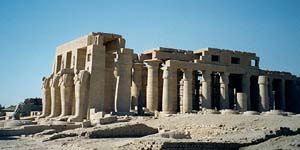 RAMESSEUM: The Ramesseum is the memorial temple of the great warrior king Ramesses II. One of the largest and best-preserved of these temples, this "Mansion of Millions of Years" contains the fallen colossus that inspired Percy Bysshe Shelleys poem, Ozymandias. Scenes from the king's great Battle of Qadesh (in which only Ramesses II's personal valor saved the Egyptians from ignominious defeat at the hands of the Hittites) adorn the first and second pylons. The king's successful campaign against the Syrian fortress of Dapur is illustrated in the hypostyle hall, along with images of the king receiving his regalia from the god Amun-Re.
The plan of the temple is typical for the New Kingdom. Behind the pylons are courts, and then a pillared hall filled with columns in the form of marsh plants, an finally a bark shrine for the sacred boat of the god and the inner sanctuary. The floor rises and the ceiling drops as one enters the temple further, to evoke the moment in which the Egyptian universe was created from the primeval mound that rose from the endless waters of the flood. The complex also includes a palace for the king and extensive storerooms and granaries built of mud brick. A large quantity of ostraca found at the site has led scholars to suggest that a scribal school or library was located here, as mentioned by the Greek historian Diodorus Siculus. RAMESSEUM: The Ramesseum is the memorial temple of the great warrior king Ramesses II. One of the largest and best-preserved of these temples, this "Mansion of Millions of Years" contains the fallen colossus that inspired Percy Bysshe Shelleys poem, Ozymandias. Scenes from the king's great Battle of Qadesh (in which only Ramesses II's personal valor saved the Egyptians from ignominious defeat at the hands of the Hittites) adorn the first and second pylons. The king's successful campaign against the Syrian fortress of Dapur is illustrated in the hypostyle hall, along with images of the king receiving his regalia from the god Amun-Re.
The plan of the temple is typical for the New Kingdom. Behind the pylons are courts, and then a pillared hall filled with columns in the form of marsh plants, an finally a bark shrine for the sacred boat of the god and the inner sanctuary. The floor rises and the ceiling drops as one enters the temple further, to evoke the moment in which the Egyptian universe was created from the primeval mound that rose from the endless waters of the flood. The complex also includes a palace for the king and extensive storerooms and granaries built of mud brick. A large quantity of ostraca found at the site has led scholars to suggest that a scribal school or library was located here, as mentioned by the Greek historian Diodorus Siculus.
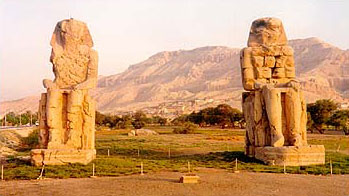 COLOSSI OF MEMNON: The twin statues depict Amenhotep III in a seated position, his hands resting on his knees and his gaze facing eastwards towards the river. Two shorter figures are carved into the front throne alongside his legs: these are his wife Tiy and mother Mutemwiya. The side panels depict the Nile god Hapy. The statues are made from blocks of quartzite sandstone. COLOSSI OF MEMNON: The twin statues depict Amenhotep III in a seated position, his hands resting on his knees and his gaze facing eastwards towards the river. Two shorter figures are carved into the front throne alongside his legs: these are his wife Tiy and mother Mutemwiya. The side panels depict the Nile god Hapy. The statues are made from blocks of quartzite sandstone.
The Colossi of Memnon are two massive stone statues of Pharaoh Amenhotep III, who reigned during Dynasty XVIII. For the past 3,400 years (since 1350 BC) they have stood in the Theban necropolis, west of the River Nile from the modern city of Luxor.
The original function of the Colossi was to stand guard at the entrance to Amenhotep's memorial temple (or mortuary temple): a massive construct built during the pharaoh's lifetime, where he was worshipped as a god-on-earth both before and after his departure from this world. In its day, this temple complex was the largest and most opulent in Egypt. Covering a total of 86 acres, even later rivals such as Ramesses II's Ramesseum or Ramesses III's Medinet Habu were unable to match it in area; even the Temple of Karnak, as it stood in Amenhotep's time, was smaller.
Included: Transfer from your metro Luxor hotel to the sites included in tour program, entry fees to sites included in tour program, Egyptologist fluent in English, bottled water during the tour, taxes and service charges.
NOT including: tips for the driver or guide, anything not specifically mentioned as included.
| Prices are per person in U$ dollars. |
| Single traveler |
$111 |
| 02-03 travelers |
$78 |
| 04-07 travelers |
$67 |
| 08 and up |
email for quote |
| Children under 12 years of age |
| Newborn through 5 years |
Free of charge |
| 6 years through 11 years |
Pay 50% of tour price |
| Age 12 and up |
Pay as adults |
Reservations
|



 Staff will meet you at your metro area Luxor hotel at 7AM for a exciting and educational day exploring the Necropolis of Thebes.
Staff will meet you at your metro area Luxor hotel at 7AM for a exciting and educational day exploring the Necropolis of Thebes.



